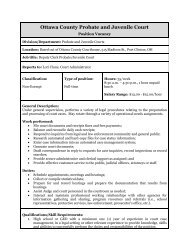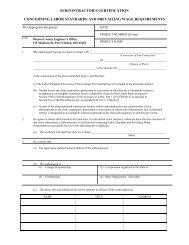ottawa county sewer district wastewater rules and regulations for ...
ottawa county sewer district wastewater rules and regulations for ...
ottawa county sewer district wastewater rules and regulations for ...
Create successful ePaper yourself
Turn your PDF publications into a flip-book with our unique Google optimized e-Paper software.
disconnection shall occur no earlier than thirty (30) days after service of<br />
a written notice of disconnection.<br />
INFILTRATION AND INFLOW<br />
TABLE “A”<br />
Calculation <strong>for</strong> Infiltration/Inflow:<br />
Since Ohio EPA uses 400 gallons per day per equivalent dwelling unit (EDU) as a<br />
design st<strong>and</strong>ard <strong>and</strong> Ottawa County uses the Ohio EPA st<strong>and</strong>ard as a basis <strong>for</strong> current<br />
billing, the SSES Policy was correlated with this st<strong>and</strong>ard while using the U.S. EPA<br />
h<strong>and</strong>book Sewer System Infrastructure Analysis <strong>and</strong> Rehabilitation <strong>and</strong> the American<br />
Society of Civil Engineers’ Existing Sewer Evaluation <strong>and</strong> Rehabilitation, WEF Manual<br />
of Practice FD-6, ASCE Manuals <strong>and</strong> Reports on Engineering Practice No. 62, second<br />
edition, as additional resources.<br />
The Ohio EPA St<strong>and</strong>ard is based on 100 gallons per capita day (gpcd) usage <strong>and</strong> four<br />
(4) people per family or 400 gpd/EDU. The Ohio EPA 100 gpcd st<strong>and</strong>ard could be<br />
further allocated as 80 gpcd <strong>for</strong> domestic flow <strong>and</strong> 20 gpcd as infiltration based on U.S.<br />
EPA criteria.<br />
The ASCE’s Exiting Sewer Evaluation <strong>and</strong> Rehabilitation, Existing Sewer Evaluation<br />
<strong>and</strong> Rehabilitation, WEF Manual of Practice FD-6, ASCE Manuals <strong>and</strong> Reports on<br />
Engineering Practice No. 62, second edition, states, “Even in a well constructed,<br />
separated system, the ratio of wet maximum to dry average usually ranges from 2 to 3<br />
<strong>and</strong> wet peak to dry average from 3 to 4; higher values indicated a more pronounced<br />
problem.<br />
A. Ohio EPA EDU = 400 gpd (based on 100 gpcd)<br />
= 320 gpd (based on 80 gpcd domestic flow)<br />
= Wet Max = 3 x 320 = 960 gpd/EDU<br />
= Wet Peak = 4 x 320 = 1,280 gpd/EDU<br />
Summary<br />
1. The highest wet maximum flow would be 960 gpd per EDU. Under no<br />
circumstances will the acceptable wet maximum flow exceed this amount.<br />
2. The highest wet peak flow would be 1,280 gpd per EDU divided by 1440 minutes =<br />
0.889 gpm. Under no circumstances will the acceptable wet peak flow rate exceed<br />
this amount.








